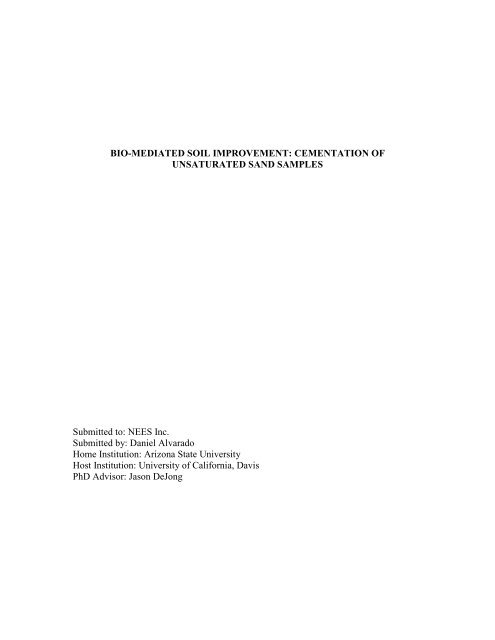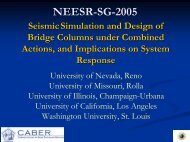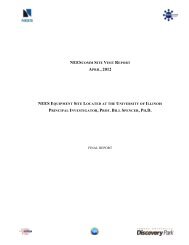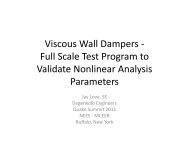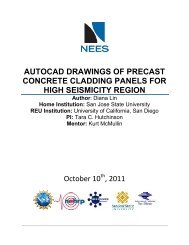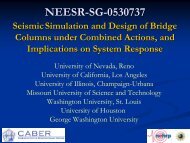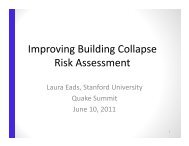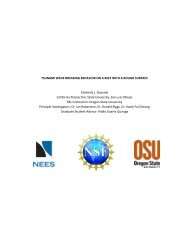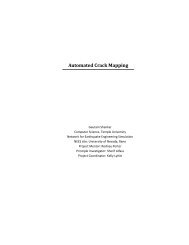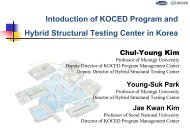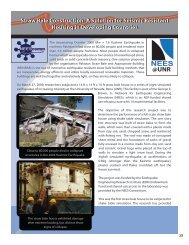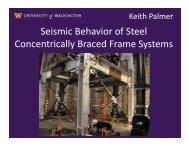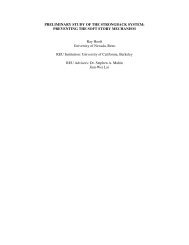BIO-MEDIATED SOIL IMPROVEMENT: CEMENTATION OF ...
BIO-MEDIATED SOIL IMPROVEMENT: CEMENTATION OF ...
BIO-MEDIATED SOIL IMPROVEMENT: CEMENTATION OF ...
You also want an ePaper? Increase the reach of your titles
YUMPU automatically turns print PDFs into web optimized ePapers that Google loves.
<strong>BIO</strong>-<strong>MEDIATED</strong> <strong>SOIL</strong> <strong>IMPROVEMENT</strong>: <strong>CEMENTATION</strong> <strong>OF</strong><br />
UNSATURATED SAND SAMPLES<br />
Submitted to: NEES Inc.<br />
Submitted by: Daniel Alvarado<br />
Home Institution: Arizona State University<br />
Host Institution: University of California, Davis<br />
PhD Advisor: Jason DeJong
Table of Contents<br />
1 Introduction ............................................................................................................. 3<br />
2 Methodology............................................................................................................ 5<br />
3 Results.................................................................................................................... 11<br />
4 Discussion.............................................................................................................. 16<br />
5 Acknowledgements................................................................................................ 17<br />
Figures<br />
Figure 1: Loose Sand to Sandstone............................................................................. 3<br />
Figure 2: Bio-Mediated Calcite Precipitation (DeJong et al) ..................................... 5<br />
Figure 3: Shear Wave Signal ...................................................................................... 6<br />
Figure 4: Scanning Electron Microscope.................................................................... 7<br />
Figure 5: Distribution of Calcite on Sand Grain Particles .......................................... 7<br />
Figure 6: Initial Load Frame Setup (not to scale)....................................................... 9<br />
Figure 7: Percolation Test 2 Setup............................................................................ 10<br />
Figure 8: Test Cell with Bender Element ................................................................. 10<br />
Figure 9: Test Cells with Bender Elements and Split Spoon Aquarium Rock ......... 10<br />
Figure 10: pH vs Time .............................................................................................. 11<br />
Figure 11: Shear Wave Velocity............................................................................... 12<br />
Figure 12: Cameco Unconfined Compression 1....................................................... 13<br />
Figure 13: Cameco Unconfined Compression 1....................................................... 13<br />
Figure 14: SEM Ottawa 50-70 before Bio-Soil Treatment....................................... 14<br />
Figure 15: SEM Ottawa 50-70 after Bio-Soil Treatment.......................................... 14<br />
Figure 16: SEM Ottawa 50-70 after Bio-Soil Treatment X 10.00k zoom on calcite<br />
structures at particle to particle contact .................................................................... 15<br />
Figure 17: SEM Ottawa 50-70 after Bio-Soil Treatment X 2.00k zoom on calcite<br />
structures at particle to particle contact .................................................................... 15<br />
Equations<br />
EQ. 1: Net Urea Hydrolysis Reaction<br />
EQ. 2: Net pH increase: [OH-] generated from NH4+ production >> [Ca2+]<br />
EQ. 3: Shear Wave Velocity V (m/s)<br />
Abstract<br />
Bio Mediated Soil Improvement (Bio-Soil) is new and innovative research within<br />
geotechnical engineering which can be used in the fields of earthquake engineering and<br />
liquefaction prevention. During events of cyclic loading from earthquakes and other<br />
events, liquefaction in loose sands can occur, causing foundation deformation and/or<br />
failure. The Bio-Soil method is an interdisciplinary field consisting of collaboration with<br />
the studies of microbiology, geochemistry, and civil engineering to find natural<br />
treatments for ground improvement. In this process, technically termed as Microbially<br />
Induced Calcite Precipitation, calcium carbonate is precipitated within the sand particles<br />
to form bonds; therefore the process transforms loose sand susceptible to liquefaction into<br />
sandstone. Laboratory findings, observations, and test results are presented along with<br />
future plans of optimization, up scaling, and transferring Bio-Soils into practical<br />
application.<br />
2
1 Introduction<br />
1.1 Current Soil Improvement Practice<br />
With over 40,000 yearly projects and approximately $6 billion/ year worldwide in the<br />
industry, new environmentally friendly techniques for soil improvement have become<br />
necessary (DeJong et al). Current grouting and ground improvement techniques in<br />
practice include grouting via cement, chemical, compaction, fracture and jet, micro piles,<br />
jacked piers, driven piers, ground anchors, shoring, soil nailing vibro compaction,<br />
concrete columns and piers (Hayward Baker). Focusing on just grouting with the<br />
exception of sodium silicate, almost all of these manmade synthetic chemical grouting<br />
techniques are hazardous and/or toxic (DeJong et al).<br />
1.2 Background and Motivation for Research<br />
The purpose of the Bio-Mediated Soil Improvement research is to find a way to use<br />
bacteria produced calcium carbonate to strengthen cohesive soils in the attempt to<br />
eliminate the risk of liquefaction and generally increase the stability of soil during events<br />
such as earthquakes, landslides, etc. Liquefaction is a geotechnical phenomenon which<br />
occurs mostly in unconsolidated saturated cohesive soils such as loose sands and silts. In<br />
the event of liquefaction, a soil’s consistency may go from a solid state to having the<br />
properties of a heavy liquid. This occurs from the rise of pore water pressures during<br />
cyclic undrained loading or softening (e.g. an earthquake) (Ishihara 353). The soil’s<br />
effective stress decreases as each grain of sand or silt is suspended and surrounded by a<br />
thin layer of water. Water has no shear strength which in effect causes structures to sink<br />
until the displaced soil matches its weight (Youd).<br />
With current practice of synthetic man made grouting techniques being harmful to the<br />
environment and people, the Bio-Soil method is being studied as a natural solution to<br />
synthetic grouting. Bacteria is harnessed to help prevent liquefaction and possibly used<br />
for other applications by forming calcite structures within the sand particles to increase<br />
the stiffness of the soil.<br />
Loose Sand Sandstone<br />
Figure 1: Loose Sand to Sandstone<br />
3
1.3 Overview of Use of Calcite Precipitation to Increase Soil Strength<br />
Bio soils are an integrated observation and experimentation between geotechnical<br />
engineering, microbiology, and chemistry. Bio mediated soil improvement is the process<br />
in which a bacteria precipitates calcium carbonate within a soil sample in attempt to<br />
increase its shear strength and overall resistance to liquefaction. Sporosarcina Pasteurii<br />
, used to precipitate the calcite, is an aerobic bacterium which is found to naturally occur<br />
in soil deposits (Fritzges). Since the bacteria are innate to the earth, it may not pose<br />
environmental risk in ideas of future in field use (Fritzges).<br />
When the bacteria are microbially induced, meaning it is controlled biologically; it can<br />
precipitate calcite through the chemical process and alter the engineering properties of<br />
loose sand. Outlined by EQ 1-2 and displayed in Fig. 1 is the chemical process involved<br />
in the precipitation of calcite throughout a typical sand sample during the biological<br />
treatment process. The main catalyst for the precipitation of calcite and food for the<br />
bacteria is the Urea Broth Solution (ubroth) consisting of variable concentrations of<br />
NaHCO3, NH4Cl, CaCl2, Urea, and Bacto (trademarked various blend of nutrients).<br />
Microbially Induced Calcite Precipitation (MICP) is a chemical process in which the<br />
bacteria consumes and breaks down urea to form ammonia, bicarbonate and carbonate<br />
ions. The calcium ions within the ubroth solution fed to the bacteria are then free to bond<br />
with the carbonate to form a level of cementation on each sand grain. This makes a<br />
more cohesive bond within the soil sample particle matrix as it is one of the most reactive<br />
and common minerals found in the earths surface (Morse). During this process the<br />
ammonia plays an important role as it helps increase the pH making an ideal environment<br />
for the bacteria to feed on the urea and precipitate calcite (Fritzges).<br />
Net Urea Hydrolysis Reaction: NH2−CO−NH2 +3H2O → 2NH4 + + HCO3 - + OH - EQ. 1<br />
Net pH increase: [OH-] generated from NH4+ production >> [Ca2+] EQ. 2<br />
4
H 2O<br />
2 Methodologies<br />
CaC0 3<br />
Ca 2+ attracted<br />
to Cell -<br />
Figure 2: Bio-Mediated Calcite Precipitation (DeJong et al)<br />
2.1 Process Monitoring and Collecting Data<br />
Characteristics of liquefaction in soils have been determined by a combination of<br />
laboratory tests of undisturbed samples and in situ tests. The in situ tests used include the<br />
standard penetration test (SPT), the cone penetration tests, and the dilatometer test.<br />
Considering these all are in situ penetration tests that are somewhat unreliable at different<br />
depths and unfeasible for lab testing, shear wave velocity measurement has also been<br />
used (Tokimasu 33).<br />
Shear Wave Velocity<br />
- - - - - - - - - - - - - - - - -<br />
-<br />
-<br />
Bacteria Cell: Sporosarcina pasteurii<br />
-<br />
-<br />
-<br />
NH2−CO−NH2 + H2O → 2NH3 + CO2<br />
-<br />
-<br />
NH3<br />
CO -<br />
2NH3 + 2H2O → 2NH4 + + 2OH -<br />
H 2O<br />
Particle<br />
The shear wave velocity is a property of soil that can help identify density and more<br />
directly stiffness (Lee). It is used directly in liquefaction analysis and to identify the<br />
general characteristics of a soil in both the lab and in situ testing (Tokimasu 33). A<br />
standard loose sand may have a shear velocity between 100-200 m/s. A liquefiable soil is<br />
any soil falling under a shear velocity of 500 m/s. The goal of the MICP is to raise that<br />
shear wave velocity above 500 m/s and to stay in the range of 500-1000 m/s with the<br />
properties more associated with that of sandstone. This shear wave velocity is the time<br />
measured using bender elements in a sample to propagate a wave and measure the return<br />
of that wave through the sample using an oscilloscope (Fritzges). Fig. 3 shows a typical<br />
shear wave signal achieved during a Bio-Soil treatment. The bottom of the first arrival<br />
time is recorded as seen in Fig. 3 as ∆T and inserted into a conversion equation EQ 1. A<br />
Bio-Soil process that is precipitating calcite will have a gradual increase in shear wave<br />
5<br />
CO2 + OH - → HCO3 -<br />
Ca 2+ + HCO3 - + OH - → CaCO3 + H2O<br />
Ca 2+<br />
+ - -<br />
Net Urea Hydrolysis Reaction: NH2−CO−NH2 +3H2O → 2NH4 + HCO3 + OH<br />
Net pH increase: [OH - + 2+<br />
] generated from NH4 production >> [Ca ]<br />
2<br />
CaC0 3<br />
CaC0 3<br />
H 2O<br />
H 2O
velocity in relation to the short time (2-4 hours, 1 treatment) after the pH reaches an<br />
average of ideal pH 9.<br />
V (m/s) = [Tip to Tip Distance of Bender Elements (mm)]/[(∆T (sec)-5)/1000] EQ. 3<br />
pH<br />
Figure 3: Shear Wave Signal<br />
PH is monitored as a technique to check if biological activity within the sand sample is<br />
occuring. The effluent of each sample is measured using a pH strip after it has been<br />
sitting in the sample for the alloted time (approx 1.5 -2.5 hours) as a reasurrance of<br />
calcite precipitating in the sand sample. The ideal range of pH falls between 8.5 and 9.3,<br />
specifically at 9 for bacteria to precipitate calcite.<br />
SEM<br />
In addition to the pH and bender element readings Scanning Electron Microscope (SEM)<br />
observations have been conducted on extruded samples to compare with data from the<br />
pumped samples. The SEM (see Fig. 4) is a tool used in most material sciences when the<br />
magnification is needed to have more contrast. How the SEM works is that it images the<br />
sample surface by scanning it with a high energy beam of electrons in a certain pattern<br />
called the raster scan pattern much like in a television. The scan gives us clear images of<br />
the topography of the item observed or as in this case the sand particles and calcite<br />
structures. The ideal distribution of calcite would be having calcite precipitated only at<br />
the particle contact points only as seen in Fig. 2. What actually happens though is most<br />
of the calcite precipitating with a layer of calcite structures forming on the sand particles.<br />
Fig. 11-14 in the Results section displays the SEM of what the percolation method’s<br />
treatment accomplished as somewhat more preferential distribution. The SEM also gives<br />
us a clear image of where the bacteria was precipitating calcite and an idea of how dense<br />
and dispersed the bacteria was throughout the sample.<br />
6
Figure 4: Scanning Electron Microscope<br />
Figure 5: Distribution of Calcite on Sand Grain Particles<br />
The data collected from both percolation device tests will give a better comparison of a<br />
non saturated sample to a saturated sample which is treated with calcite precipitation<br />
along with the effects of increasing the concentration of the ubroth.<br />
Unconfined Compression and Flow Rates<br />
Distribution Alternatives<br />
Uniform Preferential<br />
Actual<br />
7
Future additional data collected for the unconfined compression and flow rates of the<br />
percolation method in comparison to the pumping method will give valuable data on<br />
comparing to the two methods for optimization. Further tests can also be conducted after<br />
extruding the sample and performing triaxial and/or direct shear testing (DeJong et al).<br />
2.2 Set-up for the Percolation Device<br />
Several methods and variations of those methods have been used for the microbial<br />
induced cementation process at the UC Davis Soil Interactions Laboratory. The testing is<br />
still at the small scale laboratory stage with optimization as the primary objective. The<br />
current method of pumping with complete saturation has been used with several<br />
variations of continuous pumping with effluent, reverse directional pumping, nutrient<br />
circulation, and using pH and bender element readings to observe the shear wave velocity<br />
and calcite precipitation as process monitoring techniques. An additional test of<br />
observing percolation and the bacteria’s calcite precipitation through a soil sample will<br />
display valuable data to compare when a sample is not completely saturated. An<br />
important factor to note within the percolation method is that the ubroth concentration<br />
has also been increased which may have effected the results of calcite precipitated.<br />
2.3 Test 1: 4 day Percolation Test<br />
The percolation device is set up much like the standard 6 inch cells that have been used<br />
for previous tests. Four 12” cells with a 2” diameter were assembled and observed for<br />
the first percolation test. To begin, 3 large porous stones were to be used for each cell.<br />
One stone was placed on the bottom cap with the cell then connecting to the bottom cap.<br />
The soil sample was then pluviated into the cell at 4.25 inches tall. The following layer<br />
consisted of two more porous stones with a drilled top cap resting above (see Figure 6).<br />
The test cell was then placed in the load frame with 45 lbs of confining stress. A tube for<br />
effluent was attached and the test began (see Figure 6).<br />
8
8.25”<br />
Figure 6: Initial Load Frame Setup (not to scale)<br />
The percolation device test 1 spanned over a 4 day testing period. For the day 1 test a<br />
batch of bacteria with the new ubroth concentration was poured through at approximately<br />
.75 pore volumes. A three hour set time was observed just as the ubroth 1 without<br />
bacteria was allowed to percolate through. At 1.5 hours after the new ubroth 1 was<br />
introduced, the effluent was then poured through the sample and allowed to percolate<br />
through for another 1.5 hours. During this time, pH readings were made to make sure<br />
that precipitation was occurring along with observation of percolation using different<br />
colored dyes. After this 3 hour time for the ubroth 1 a new batch of ubroth 2 was made<br />
and allowed to percolate through at the same method. This process continued until 12<br />
AM where day 1 was complete. Day 2 began the next day at 6 AM and observed the<br />
same process excluding the initial bacteria ubroth. This process continued for days 3 and<br />
4 with the same procedure. At the end of day 4 the sample was then allowed to be<br />
extruded, cleaned, and observed for calcite precipitation. The final step was to clean up<br />
the equipment and gather the effluent pH data and observations for analysis.<br />
2.4 Percolation Test 2: Bender Elements<br />
3’<br />
12”<br />
The percolation device test 2 is identical to the original 4 day span test with the addition<br />
of bender elements on the cells and test time decrease to 48 hours (see Figures 7-9).<br />
Ottawa 20-30, 50-70 and Aquarium Rock are more poorly graded sands or samples used<br />
in Test 2 with bender elements. Cameco being a more well graded sand is also sampled<br />
with bender elements for Test 2. As pH readings are being taken the bender elements are<br />
used to collect shear wave velocities throughout the test. In addition to the 4 bender<br />
9<br />
4.25”<br />
45lbs<br />
1.5’
element cells, several other cells were set up to observe flow rates, pH, and allow for<br />
more extruded samples to be measured with unconfined compression. Data is to be<br />
collected and analyzed to compare the change in shear wave velocity as calcite is<br />
precipitated over time.<br />
Figure 7: Percolation Test 2 Setup<br />
Figure 8: Test Cell with Bender Element<br />
Figure 9: Test Cells with Bender Elements and Split Spoon Aquarium Rock<br />
10
3 Results<br />
Using the process monitoring techniques of pH levels, shear wave velocity, unconfined<br />
compression, flow rates, and scanning electron microscopy (SEM), valuable data has<br />
been collected to help optimize the biological process of calcite precipitation. The<br />
following results and data observations were made from Percolation Test 2 conducted<br />
over 48 hours.<br />
Observing Fig. 6 the pH reached the optimum range pH between 8.5 and 9.3 after<br />
approximately 20 hours of treatment. This steady measurement averaging out to a pH of<br />
9 is the ideal environment for the bacteria to precipitate calcite.<br />
pH<br />
9.5<br />
9.0<br />
8.5<br />
8.0<br />
7.5<br />
pH<br />
7.0<br />
0.00 4.00 8.00 12.00 16.00 20.00 24.00 28.00 32.00 36.00 40.00 44.00 48.00<br />
Time (hr)<br />
Figure 10: pH vs. Time<br />
11<br />
Aquarium Rock<br />
Ottawa 20-30<br />
Cameco<br />
Ottawa 50-70
Observing Figure 11 the shear wave velocity of 500 m/s, beyond the limit of a liquefiable<br />
soil, correlates with the ideal pH level of 9 as most of the test samples reach over that<br />
level at about 25 hrs into the test. The highest shear wave velocity of 1600 m/s occurs in<br />
the Ottawa 20-30 sample which is a poorly graded sand sample.<br />
Shear Wave Velocity (m/s)<br />
1800.0<br />
1600.0<br />
1400.0<br />
1200.0<br />
1000.0<br />
800.0<br />
600.0<br />
400.0<br />
200.0<br />
Aquarium Rock<br />
Ottawa 20-30<br />
Cameco<br />
Ottawa 50-70<br />
Shear Wave Velocities<br />
0.0<br />
0.00 4.00 8.00 12.00 16.00 20.00 24.00 28.00 32.00 36.00 40.00 44.00 48.00<br />
Time (hr)<br />
Figure 11: Shear Wave Velocity<br />
Figures 12 (psi) and 13 (kPa) display the unconfined compression results obtained from<br />
the Cameco sand sample. The maximum stress of approximately 300 psi and strain of<br />
1.39% was achieved before any cracking or deformation occurred.<br />
12
Stress (psi)<br />
Stress (kPa)<br />
350.00<br />
300.00<br />
250.00<br />
200.00<br />
150.00<br />
100.00<br />
50.00<br />
Cameco Unconfined Compression<br />
0.00<br />
0.00% 0.20% 0.40% 0.60% 0.80% 1.00% 1.20% 1.40% 1.60%<br />
2500.00<br />
2000.00<br />
1500.00<br />
1000.00<br />
500.00<br />
Strain (%)<br />
Figure 12: Cameco Unconfined Compression 1<br />
Cameco Unconfined Compression<br />
0.00<br />
0.00% 1.00% 2.00% 3.00% 4.00% 5.00% 6.00% 7.00%<br />
13<br />
Strain (%)<br />
Figure 13: Cameco Unconfined Compression 1
The SEM images (Figures 14-17) display the before and after affect of Bio-Soil treatment<br />
for the Ottawa 50-70 sample for the Percolation Test 2. Figure 14 displays the gaps and<br />
voids in which water can fill during an earthquake leading to liquefaction. Figure 15 is<br />
an overview of the treated sand sample with calcite precipitated throughout the soil<br />
sample. Closely observing the Ottawa 50-70 from the zoom on the calcite structures (see<br />
Figures 16-17) the preferential precipitation of calcite at the particle contacts can be seen.<br />
Also, observing Fig. 17 the bacteria indentations can be seen as being dispersed<br />
throughout the entire calcite structure. It can be roughly assumed that with these SEM<br />
observations that calcite was evenly distributed throughout the Ottawa 50-70 sample.<br />
Figure 14: SEM Ottawa 50-70 before Bio-Soil Treatment<br />
Figure 15: SEM Ottawa 50-70 after Bio-Soil Treatment<br />
14
Figure 16: SEM Ottawa 50-70 after Bio-Soil Treatment X 10.00k zoom on calcite<br />
structures at particle to particle contact<br />
Figure 17: SEM Ottawa 50-70 after Bio-Soil Treatment X 2.00k zoom on calcite<br />
structures at particle to particle contact<br />
15
4 Discussion<br />
4.1 Optimization<br />
The main goal of research to be achieved in the 2008 summer REU program was<br />
optimization of the laboratory Bio-Soil treatment methods. The first month involved<br />
pumping treatments through fully saturated samples. The next 6 weeks involved the<br />
percolation of treatments through unsaturated samples with increased ubroth<br />
concentrations. It has been observed that the percolation method has displayed results of<br />
stiffer extruded sand samples. It is still unknown if these results occur from the actual<br />
method of percolation or the fact that the ubroth concentration increase may give the<br />
bacteria more to feed on and precipitate calcite or possibly a combination of both.<br />
Calculations of the number of particle to particle contacts and volume of liquid retained<br />
at those contacts are currently being conducted as a way to better optimize and<br />
understand the effect of unsaturated media and varying the concentration of ubroth.<br />
4.2 Up scaling<br />
Recent funding for the up scaling to centrifuge modeling has been approved for future<br />
research studies of Bio-Soil treatments. The UC Davis centrifuge will be used in<br />
conjunction with the findings from laboratory tests from the SIL to move closer to<br />
practical field applications.<br />
4.3 Future Research and Goals<br />
Some purpose to the further conduction of these tests may also come from the correlation<br />
of shear wave velocity to liquefaction resistance having fairly new findings with limited<br />
field testing (Tokimasu 34). There have been recent advances in the research of bio<br />
mediated soil improvement to allow for more accurate measurements of bacteria calcite<br />
precipitation and up-scaling to centrifuge experiments (DeJong et al). The accuracy may<br />
increase from the measurement of the ratio between urea injected and urea found in the<br />
effluent measured by a spectrometer as the centrifuge tests will give more “in field”<br />
results (DeJong et al). The Nesslerization Method of using spectrometer readings from<br />
ammonia in ubroth effluent will assist in the optimization of both laboratory tests and<br />
centrifuge modeling for the Bio-Soil process. The end result may be achieved in the<br />
possible future replacement of chemical and synthetic man made grouting techniques of<br />
today and with the natural, more environmentally friendly Bio-Mediated Soil<br />
Improvement techniques.<br />
16
5 Acknowledgements<br />
The research conducted at the University of California, Davis is supported by the George<br />
E. Brown, Jr. Network for Earthquake Engineering Simulation (NEES) with funding<br />
provided by the National Science Foundation (NSF). A special thanks is extended out to<br />
NEES CEO Steve McCabe and all NEES staff for offering opportunities to<br />
undergraduates to obtain research experience and including but not limited to the Soil<br />
Interactions Laboratory PI Jason DeJong, Centrifuge PIs Bruce Kutter and Dan Wilson,<br />
graduate student mentors Brina Mortensen, Brian Martinez, Matt Weil, Robbie Jaeger<br />
and Nick Yafrate, and undergraduate student researcher Jack Waller.<br />
17
References<br />
DeJong, Jason et al [2008]. “Bio-Mediated Soil Improvement,” 1 st International<br />
Conference on Bio-Geo-Civil Engineering. Delft, The Netherlands.<br />
Fritzges, Michael B. [2005]. “Biologically Induced Improvement of the Response of<br />
Sands to Monotonic Loading”, M.S. thesis, Department of Civil & Environmental<br />
Engineering., University of Massachusetts, Amherst, Massachusetts.<br />
Ishihara, K. [1993]. “Liquefaction and flow failure during earthquakes”,<br />
Geotechnique 43, No. 3, 351-415<br />
Hayward Baker. Services. 2003. 9 Sept 2008<br />
<br />
Lee, J.S., and Santamarina, J.C. [2007]. “Seismic monitoring short-duration events:<br />
liquefaction in 1g models”, Canada Geotech. J. 44: 659-672<br />
Morse, J.W. [1983]. “ The Kinetic of Calcium Carbonate Dissolution Precipitation”,<br />
Carbonates: Geology and Chemistry, 227-264<br />
Tokimatsu, K., and Uchida, A. [1990]. “Correlation Between Liquefaction Resistance<br />
And Shear Wave Velocity”, Soils and Foundations, Vol. 30, No.2, 33-42<br />
Youd, T.L., and Idriss, I.M. [2001]. "Liquefaction Resistance of Soils: Summary report<br />
from the 1996 NCEER and 1998 NCEER/NSF Workshops on Evaluation of<br />
Liquefaction Resistance of Soils", Journal of Geotechnical and<br />
Geoenvironmental Engineering, ASCE, 127(4), 297-313<br />
18


